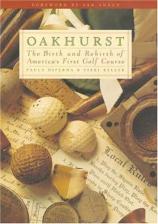Oakhurst
Review
Oakhurst
In March of 1947 the Broadway team of Lerner and Lowe premiered
their first musical hit, "Brigadoon." The story revolves around two
Americans traveling in Scotland who discover a misty Scottish
village. They soon discover that the quaint little town only
appears for one day every 100 years. The reader of OAKHURST by
Paula Diperna and Vikki Keller will be reminded of the village of
Brigadoon and the memory of a different and quieter time when not
only the world, but also the world of golf, was a far different
experience.
In 1884, on a 35-acre plot of land in Sulpher Springs, West
Virginia, Russell Montague and three Scottish friends plotted a
nine-hole golf course. The course was named Oakhurst Links. Its
owners, designers, and players were unaware that it was the first
golf course in the United States. Oakhurst, however, would not be
able to lay claim to its title as America's first course for very
long. By 1900 Oakhurst was just an overgrown field used for
anything but golf. As Russell Montague would later remark, "Well,
the boys just drifted away."
West Virginia is the home state of golfing legend Sam Snead. Snead,
who recently died at the age of 89, became intrigued with the
Oakhurst golf course when he occasionally hit practice balls there
in the 1930s. In 1959 he learned that the ground was for sale.
Snead convinced his friend Louis Keller to purchase the land. Thus
began a 30-year effort to painstakingly reconstruct the Oakhurst
Links.
If the story ended with the reopening of Oakhurst it would
certainly be an interesting tale. But Oakhurst is more than a golf
course brought back from years of inattention. Like Brigadoon,
Oakhurst returned as a golf course that exists precisely as it
existed when opened. Rather than fancy lawnmowers, sheep graze on
the course and keep the grass cut. There are no Big Bertha drivers
or graphite shafted irons allowed on the course, nor may a player
choose between Titleist or Nike golf balls. Only equipment used in
the 1880s is allowed at Oakhurst. Hickory shafted clubs and
gutta-percha balls are the tools of Oakhurst. Even wooden tees are
not allowed. To tee the ball, golfers take a small dab of sand and
place the ball on the ground. As a final touch, each year the club
holds the National Hickory Championship. Participants are required
to wear golf apparel appropriate for the 1880s.
Oakhurst is available for public play, and information is provided
in the book about playing the course. The authors have written a
loving book about not only the rebirth of a golf course, but the
chance to return to a time when golf was played in a far different
and less hectic manner. For those who long to return to that
spirit, OAKHURST is a must read. Golf historians will also find
this a book that will add to their knowledge of the beginnings of
golf in North America. Anyone who loves and enjoys golf should pick
up this book and start planning a trip to West Virginia. I hope to
see you on the first tee. I'll be the one in the gray plus
fours.
Reviewed by Stuart Shiffman on January 22, 2011
Oakhurst
- Publication Date: April 1, 2002
- Genres: Nonfiction, Sports
- Hardcover: 196 pages
- Publisher: Walker & Company
- ISBN-10: 0802713718
- ISBN-13: 9780802713711



